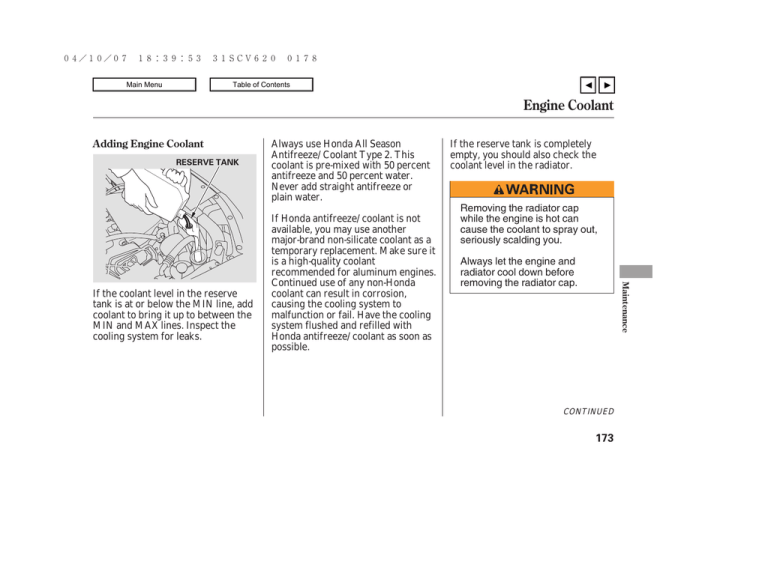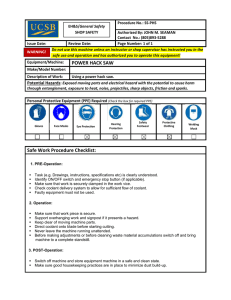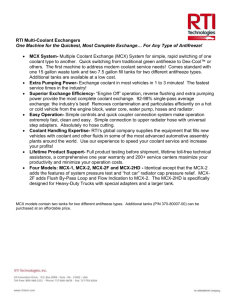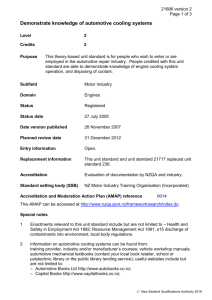Engine Coolant - Techinfo
advertisement

Table of Contents ▼ Main Menu ▲ 04/10/07 18:39:53 31SCV620 0178 Engine Coolant Adding Engine Coolant RESERVE TANK If Honda antifreeze/coolant is not available, you may use another major-brand non-silicate coolant as a temporary replacement. Make sure it is a high-quality coolant recommended for aluminum engines. Continued use of any non-Honda coolant can result in corrosion, causing the cooling system to malfunction or fail. Have the cooling system flushed and refilled with Honda antifreeze/coolant as soon as possible. If the reserve tank is completely empty, you should also check the coolant level in the radiator. Removing the radiator cap while the engine is hot can cause the coolant to spray out, seriously scalding you. Always let the engine and radiator cool down before removing the radiator cap. Maintenance If the coolant level in the reserve tank is at or below the MIN line, add coolant to bring it up to between the MIN and MAX lines. Inspect the cooling system for leaks. Always use Honda All Season Antifreeze/Coolant Type 2. This coolant is pre-mixed with 50 percent antifreeze and 50 percent water. Never add straight antifreeze or plain water. CONTINUED 173 Table of Contents ▼ Main Menu ▲ 04/10/07 18:40:06 31SCV620 0179 Engine Coolant, Windshield Washers RADIATOR CAP 3. The coolant level should be up to the base of the filler neck. Add coolant if it is low. Pour the coolant slowly and carefully so you do not spill. Clean up any spill immediately; it could damage components in the engine compartment. 4. Put the radiator cap back on and tighten it. 1. When the radiator and engine are cool, relieve any pressure in the cooling system by turning the radiator cap counterclockwise, without pressing down. 2. Remove the radiator cap by pushing down and turning counterclockwise. 174 5. Pour coolant into the reserve tank. Fill it to halfway between the MAX and MIN marks. Put the cap back on the reserve tank. Do not add any rust inhibitors or other additives to your vehicle’s cooling system. They may not be compatible with the coolant or engine components. Windshield Washers Check the fluid level in the windshield washer reservoir at least monthly during normal use. On Canadian models: The low washer level indicator comes on when the level is low (see page 57 ). Fill the reservoir with a good-quality windshield washer fluid. This increases the cleaning capability and prevents freezing in cold weather. When you refill the reservoir, clean the edges of the windshield wiper blades with windshield washer fluid on a clean cloth. This will help to condition them. Do not use engine antif reeze or a vinegar/water solution in the windshield washer reservoir. Antif reeze can damage your vehicle’s paint, while a vinegar/water solution can damage the windshield washer pump. Use only commercially-available windshield washer f luid. Table of Contents ▼ Main Menu ▲ 04/10/07 18:40:20 31SCV620 0180 Automatic Transmission Fluid DIPSTICK UPPER MARK LOWER MARK 1. Park the vehicle on level ground. Shut off the engine. 2. Remove the dipstick (yellow loop) from the transmission, and wipe it with a clean cloth. 3. Insert the dipstick all the way into the transmission securely. 4. Remove the dipstick and check the fluid level. It should be between the upper and lower marks. 5. If the level is below the lower mark, add fluid into the filler hole to bring it to the upper mark. Pour the fluid slowly and carefully so you do not spill any. Clean up any spills immediately; it could damage components in the engine compartment. 6. Insert the dipstick all the way back in the transmission. The transmission should be drained and refilled with new fluid according to the time and distance recommendations in the maintenance schedule. If you are not sure how to add fluid, contact your dealer. 175 Maintenance Check the fluid level with the engine at normal operating temperature. Always use Honda ATF-Z1 (automatic transmission fluid). If it’s not available, you may use a DEXRON III automatic transmission fluid as a temporary replacement. However, continued use can affect the shift quality. Have the transmission flushed and refilled with Honda ATF-Z1 as soon as it is convenient. To thoroughly flush the transmission, the technician should drain and refill it with Honda ATF-Z1, then drive the vehicle for a short distance. Do this three times. Then drain and refill the transmission a final time. Table of Contents Manual Transmission Fluid Manual Transmission Fluid WASHER FILLER BOLT Correct Level Check the fluid level with the transmission at normal operating temperature and the vehicle sitting on level ground. Remove the transmission filler bolt, and carefully feel inside the bolt hole with your finger. The fluid level should be up to the edge of the bolt hole. If it is not, add Honda manual transmission fluid (MTF) until it starts to run out of the hole. Reinstall the filler bolt, and tighten it securely. 176 If Honda MTF is not available, you may use an SAE 10W-30 or 10W-40 viscosity motor oil with the API Certification seal that says ‘‘FOR GASOLINE ENGINES’’ as a temporary replacement. However, motor oil does not contain the proper additives, and continued use can cause stiffer shifting. Replace as soon as it is convenient. The transmission should be drained and refilled with new fluid according to the time and distance recommendations in the maintenance schedule. ▼ Main Menu ▲ 04/10/07 18:40:29 31SCV620 0181




